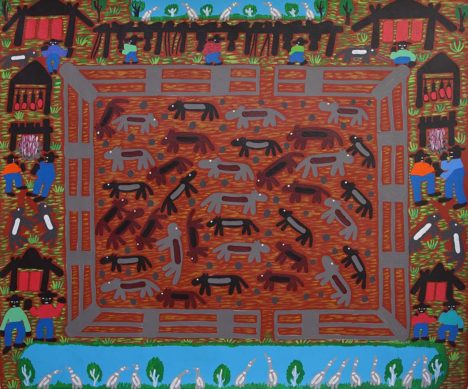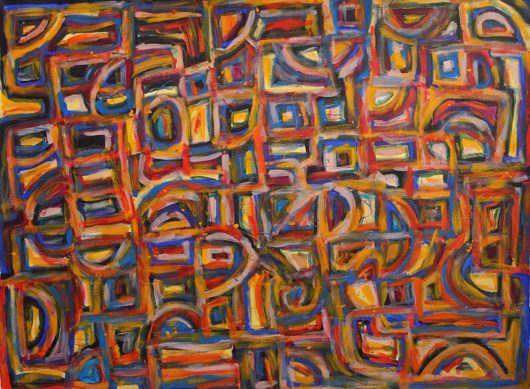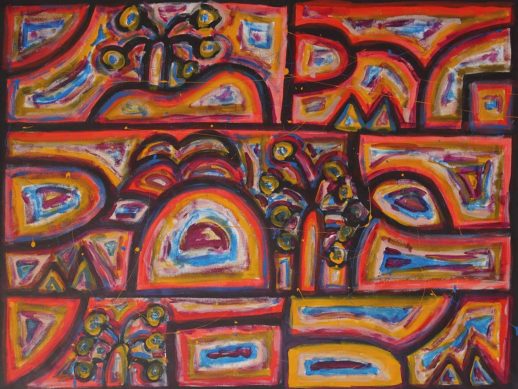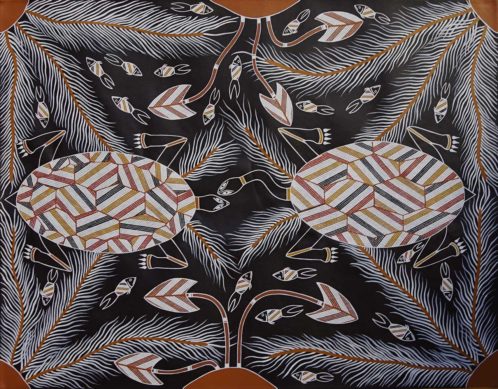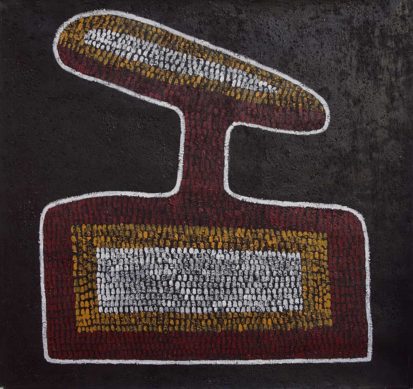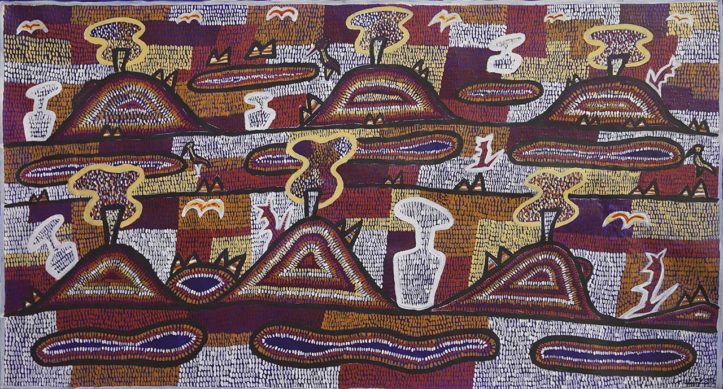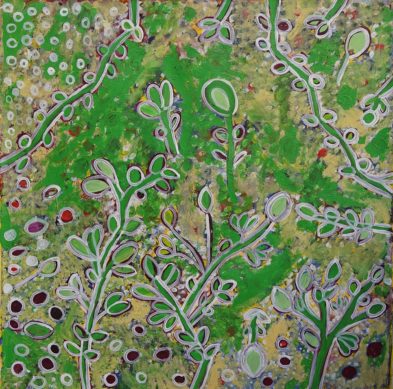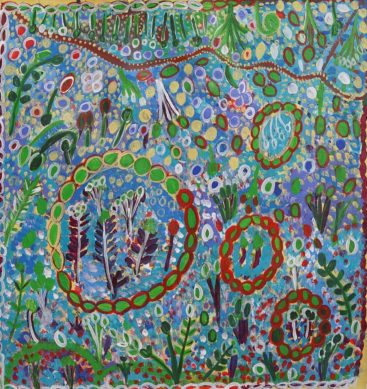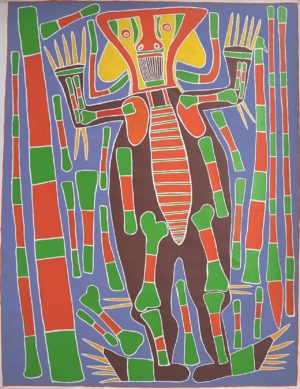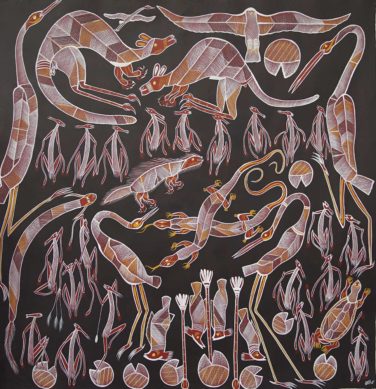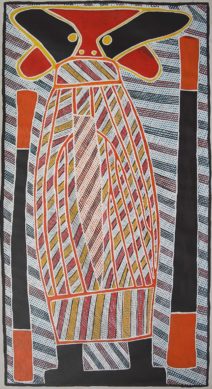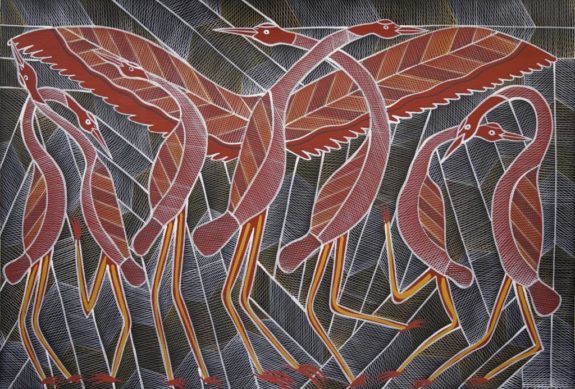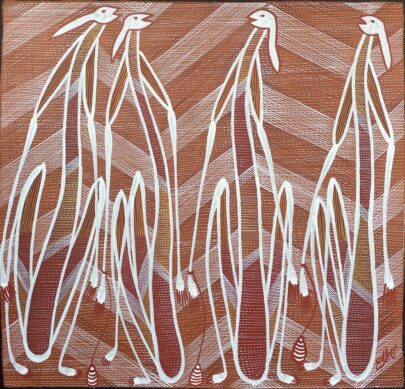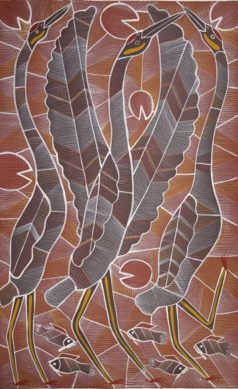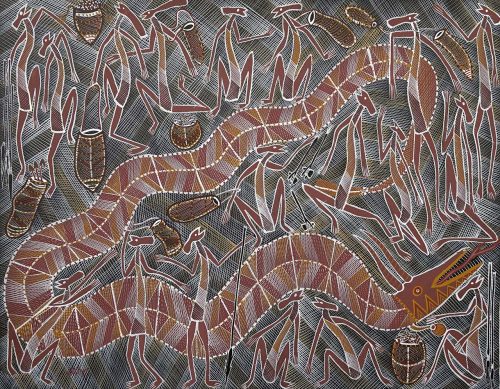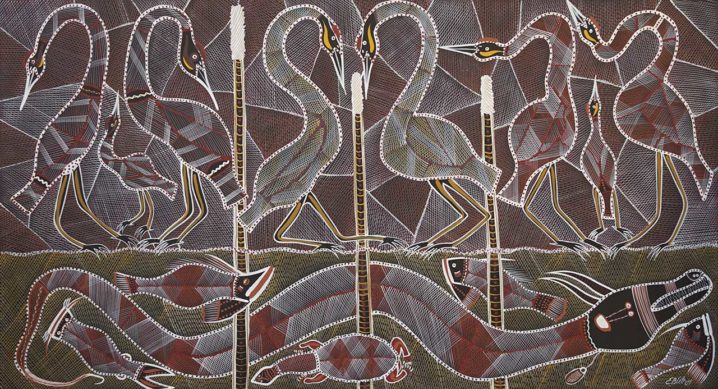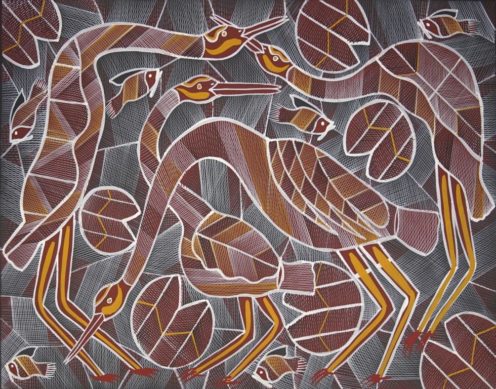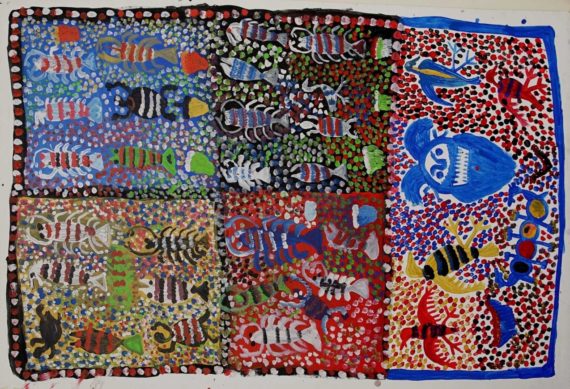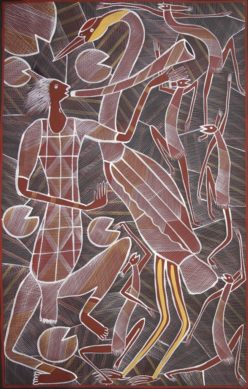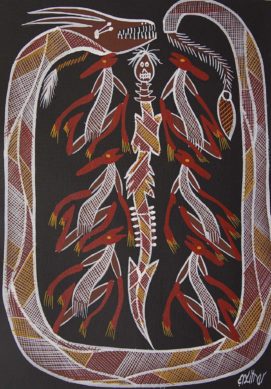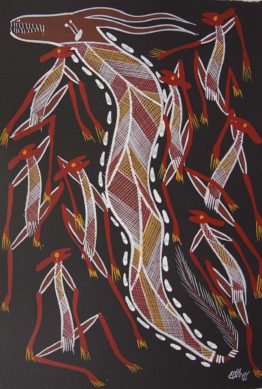Roper River Ngukurr Aboriginal Art
A selection of paintings showing the styles from this Aboriginal art region - some paintings may still be available for sale, while some may have been sold.
Roper River is one of the largest rivers in the Northern Territory, extending east for over 500 km through south-east Arnhem Land to meet the sea in Limmen Bight on the Gulf of Carpentaria. The river is navigable for about 145 km until the tidal limit at Roper Bar, and forms the southern boundary of the region of Arnhem Land.
Ngukurr is an Aboriginal Community built on hilly ground alongside the Roper River, and is three hours by road from the nearest town of Katherine. During the Wet Season, from December to May, access is limited either by air or by boat. The community of about 800 people comes from nine different language groups, many of whom are displaced from their ancestral lands. The community grew out of the Roper River mission, established in 1908 by the Church Missionary Society as a refuge for dispossessed Aboriginal people. Ngukurr has been administered since 1968 by an Aboriginal council of elders and landowners.
The first paintings from Ngukurr date from 1987, and since then the community has emerged with its own vibrant and dynamic art style, reflective of the artists’ different histories and groundings in culture. Well known artists from the region include Gertie Huddleston, Angelina George, Amy Johnson, Ginger Riley, Willie Gudapi, Barney Ellaga and Djambu Barra Barra.
Further information is available on exhibiting artists on the following links
Djambu Barra Barra Artist Bio & Artworks
Edward Blitner Artist Bio & Artworks
Artists from Ngukurr – Exhibition 2016
Interview with Jude Emmet, Manager Ngukurr Arts Aboriginal Corporation
Ngukurr is a remote Indigenous community on the banks of the Roper River in Southeast Arnhem Land in the Northern Territory. Jude Emmett is Manager of the Ngukurr Arts Aboriginal Corporation. In this interview he talks about Ngukurr Arts, the work of the artists and the sense of optimism about the future.
Can you describe your role at Ngukurr Arts Centre?
For me, the manager role is the broadest scope of what is possible in a job. I might go out hunting first thing in the morning with a senior person to get kangaroo for the artists’ lunch. Then I might do some bookkeeping, write a report or do a grant submission. I always spend some part of every day talking with the artists. This is often to help them form a critical eye to develop their paintings and practice. In the afternoon we might be cutting down a tree with a chainsaw for the woodworkers. All of these things are a part of my role.
I’ve worked in a few art centres now. I guess you learn that in the arts, you have to take on many different roles. You’re not an expert in all of the elements that make an art centre run so it’s about bringing in people you trust – trusting your directors, trusting staff to do their job, and just getting on with it.
Can you paint me a picture of what the Art Centre is like?
It’s an old school building. It’s just one large room with a little office on one side and verandah out the front. It operates as a studio and gallery. People paint on the verandah and inside the studio. There are two printmaking tables. One is for fabric and the other is for lino and woodblock. It is a pretty squashy space because eighty percent of its function is a working art studio. There are paintings stacked at the side, tables, and paint tins everywhere.
There are about six artists who work inside and about the same who work outside. Outside, under a tree and a shade cloth there is a woodworking space just off the verandah. There are a couple of workbenches, chainsaws, grinders and chisels. So the old and young men tend to work out the front. The painters and printmakers tend to work inside and on the side veranda. There is also a shed out the back. It’s a reclaimed space but not many people like to work on their own out there. I think when an artist goes out there they feel like they’re missing out on the action. Ngukurr Art Centre is a very social and communal space.
How many artists do you have in total who use the Centre?
It’s difficult to get an accurate number because it varies day to day but most days there are about fifteen artists working inside or out the front of the Art Centre. Then there are about another twenty artists who come and go.
Tell me about the community itself. How many people live at Ngukurr?
It’s the third biggest community in Arnhem Land. About 1,000 people live here but that can swell to 1,500. The Art Centre is at the end of a street before the river so it has a peaceful vibe. The mean age of the community is about 22. It’s a young population. But at the Art Centre, while we do have some young artists coming in now, most of the artists are older community members.
How remote is the community?
It is about 400 km from Katherine. That includes about 100 km of unsealed roads. There will be some bridges built on those roads over the coming years. At the moment the community is usually cut off for most of the wet season.
What makes this community unique?
Ngukurr started as a mission town back in 1908. This is not an uncommon experience for communities in this region. What is unique is that people came from far and wide. There are seven main language and cultural groups in town as well as two others that aren’t as common. Our directors are made up of one of each of the seven main language groups.
What it has meant in terms of creating art is that there is not a singular style that people are following. There is no singular attitude or line of thought or trend. The nine language groups mean there are so many different painting styles. There are so many different thought lines. So everyone has become maverick with their own style.
That was really evident even from the early stages of the Ngukurr Art Centre scene. People were always painting in bold colours here but everyone has been developing their own style. They were telling traditional stories but not necessarily using traditional colours or ways of applying paint. That said, there were people like Djambu Barra Barra who did use a traditional Rarrk technique. Today, in some of his work, his grandson Wally Wilfred continues that tradition.
How strong is the art making tradition at Ngukurr?
I think the Art Centre has become a cultural magnet in Ngukurr. There is a strong history of great artists from this area. They painted significant and important stories and this continues today.
How do the new generation of artists regard the artwork of the earlier Ngukurr artists?
In the last year or so I’ve seen people starting to look more at the work of the old artists. The current artists are looking at what was great about the work of those who have gone before. Unfortunately, the Art Centre doesn’t have a great collection of works from those old artists. That is partly because we don’t have the space. Many of those artists worked before the Art Centre had evolved and they were signed on with dealers. There hasn’t been a lot of work left behind for the current artists to see.
This is something that we hope to rectify in the coming years. We want to try and start building up a collection of works. We want people here to be able to see and learn from the work of the earlier artists.
So is the inter-generational effect important for the Art Centre?
Yes. Absolutely. There are often grandparents working with children, grandchildren, aunts, and uncles. If I looked out the front right now there are people doing woodwork and sculpting ranging from their 20s to their mid-70s. Everyone here is related in some way or another.
What makes a good art community from your experience?
I think that every artist needs different things to stimulate their creativity and sometimes different working conditions. Good tools and materials are always going to be a positive thing. However, some people like to work in a quiet environment while others thrive in a messy or a noisy environment.
A big part of my role is trying to find out what makes each artist tick. I then try to provide what they need, such as the environment that will allow them to do their best work. It might be talking and joking with some of the older women or even talking about technique. It could be a whole range of things. I do think that collectively there is a great feeling here. It is a great place to be.
What are the options for younger artists at Ngukurr today?
There have been a couple of good sculpture projects to attract younger people in. Also, we’ve run a number of printing workshops. We are just in the process of starting a music programme which will have a multimedia component to it.
Some younger artists here are interested in video production. Next month we’re flying off to see another community project for a couple of days. We’ll spend a few days with them checking out how they do things.
Young people have had such a different experience than the generation before them or their grandparents. They are quite savvy with technology and the Internet. I think it will be an exciting ten years ahead as those technologies are recognised as a way to create art.
I’ve been working in remote communities for fifteen years now. I don’t know if it’s Ngukurr at large or the positivity of the senior authority figures here but there is a real optimism about the future. Young people here are learning their language and learning about their culture. They are also embracing Western technology, smartphones, creating images and all that technology allows. It is becoming part of the whole.
I think what is going to happen and what is already happening is this great, new, and unique kind of culture. What is coming out of these communities draws from a broad range of influence. This could be black hip-hop and Bollywood right through to all the traditional song lines and language. It all blends with what has been part of the traditional culture for hundreds of thousands of years. I think as the younger generation find their voice it will be really exciting to see and hear what they create.
What do you think the current artists make of the process once their paintings leave for an exhibition?
I think there is a great disparity here. Some people understand what’s going on. Other artists just ask me on a daily basis, “Has my painting sold?”
Some people grew up in the mission in the dormitories and they are educated and experienced in Western ways. Other people grew up in the bush and walked all around outer lands with their families. They are still making sense of the Western way of doing things which is so different from how they do things.
What do you think that the galleries can do that is most beneficial for your local artists?
I guess the philosophy that the directors, the artists, and myself have started here is to do good work. Just do good work, and good things will follow. Don’t worry about the outcome too much. I’d encourage the galleries to go for the best and be ethical in what that they do.
I think galleries are important because they can help us educate the broader community to understand that Aboriginal art isn’t just bark painting or dot painting. There is cultural significance in contemporary work. I guess that is the main obstacle that artists face. Visitors may take a look at the art and say, “That is not Aboriginal art, it is contemporary art.” It is both of those things and it ties into a rich and living culture.
The art can draw from abstract art, from what people read in books or watch on television. It can draw from a whole range of things. This doesn’t make it less. It is still created by Aboriginal artists and there is a story that is being told. Galleries can start conveying that story.
These remote communities can be hard places. There is violence and resources are scarce. What is equally true is that these places are also vibrant. They are full of people who are creative and wonderfully familiar with each other and the land. All of those things coexist. We are under-resourced here and overcrowded but that is one part of the picture and we’re doing our best to address it. Despite obstacles, these communities are vibrant, rich in culture and unique.
Read more about Arts Centre management:
Australian Aboriginal Art Centre Management

